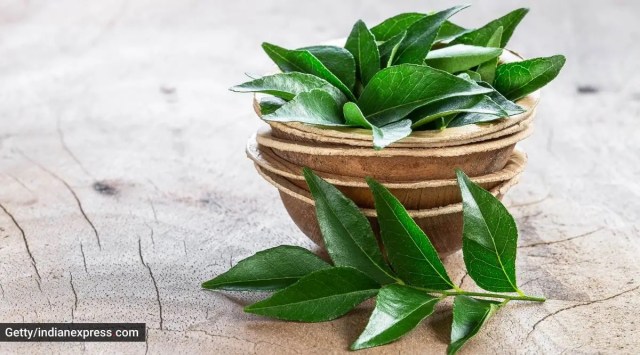📣 For more lifestyle news, click here to join our WhatsApp Channel and also follow us on Instagram
How to use curry leaves more effectively?
Bhakti Kapoor, nutritionist, wellness consultant, and founder, Healthy High, Mumbai said curry leaves can be used effectively in various ways to get great flavours
 Have curry leaves in varied forms to tackle lifestyle issues. (Source: Getty Images/Thinkstock)
Have curry leaves in varied forms to tackle lifestyle issues. (Source: Getty Images/Thinkstock) Nutrition is all about optimising what you have to make it more useful for your body. As such, one of the key ingredients found in our daily cooking is curry leaves. These leaves are said to be extremely potent for health as they help combat several issues, including skin and hair concerns.
Bhakti Kapoor, nutritionist, wellness consultant, and founder, Healthy High, Mumbai agreed and shared that curry leaves offer several health benefits. “They are rich in antioxidants, which can help protect cells from damage. They also have anti-inflammatory properties and may aid digestion by reducing the risk of stomach ulcers and promoting gut health. Some studies suggest that curry leaves may help manage blood sugar levels and reduce cholesterol. Additionally, these leaves contain vitamins and minerals that contribute to hair and skin health,” Kapoor said.
As such, when gut microbiome specialist Shonali Sabherwal addressed how to make the most use of curry leaves, we took note.
Incorporating curry leaves into your meals not only adds a burst of flavour but also delivers a dose of health benefits, said Sabherwal.
“Known to release a powerful enzyme called alpha-amylase, which breaks down dietary starch to glucose. So, it is a natural blood sugar regulator. In Traditional Chinese Medicine, it is also bitter, so the liver loves bitter and in Ayurveda, bitter combats sweetness; therefore, the diabetes connection,” added Sabherwal.
Some other uses of curry leaves, according to Sabherwal:
Nausea: Fry them (6 fresh curry leaves, washed, dried, and half a teaspoon of ghee), cool, and eat
Bad breath: Fresh curry leaves (five curry leaves), chew for five minutes, then rinse mouth with water
Diarrhoea: Curry-leaf paste (30 leaves), grind into a paste, and mix in almond milk watered down. Can also eat directly.
Diabetes: Chutney, which can be eaten with food, in a roti roll, or mixed in anything.
View this post on Instagram
According to Kapoor, curry leaves can be used effectively in various ways to get great flavours. “You can add them while tempering oil at the beginning of cooking, blend them into chutneys or sauces, or even infuse them into oils for a subtle aroma. Additionally, drying and crushing curry leaves can create a versatile seasoning. Remember that their flavour is potent, so use them in moderation,” said Kapoor.
📣 For more lifestyle news, follow us on Instagram | Twitter | Facebook and don’t miss out on the latest updates!
📣 For more lifestyle news, click here to join our WhatsApp Channel and also follow us on Instagram
Photos



- 01
- 02
- 03
- 04
- 05
























